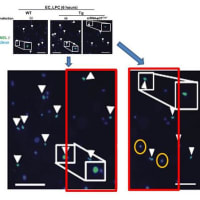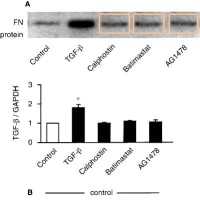画像類似の論文#5
Matsubara H (corresponding author), Shibasaki Y, Okigaki M, Mori Y, Masaki H, Kosaki A, Tsutsumi Y, Uchiyama Y, Fujiyama S, Nose A, Iba O, Tateishi E, Hasegawa T, Horiuchi M, Nahmias C, Iwasaka T.
Effect of angiotensin II type 2 receptor on tyrosine kinase Pyk2 and c-Jun NH2-terminal kinase via SHP-1 tyrosine phosphatase activity: evidence from vascular-targeted transgenic mice of AT2 receptor.
Biochem Biophys Res Commun. 2001 Apr 20;282(5):1085-91.
Department of Medicine II, Kansai Medical University, Moriguchi, Osaka, Japan
責任著者 : 松原弘明、 筆頭著者 : 松原弘明
松原弘明氏の論文発表当時の所属 : 関西医科大学第二内科
画像類似指摘項目No.8
論文#5(BBRC 2001:282:1085-1091) のFig.2Cの「Wild-type」のグラフと「SHP1-DN1」のグラフが互いに類似しています。
画像類似指摘項目No.9
・論文#5のFig.2Bの二つのグラフは、論文#2のFig.2Bの二つのグラフに類似しています。
・また、論文#5のTable 1と、論文#2 のTable 1が類似しています。
・また、論文#5のFig.4の「GAPDH」の画像と、論文#2のFig.4の「GAPDH」の画像が類似しています。
・また、論文#2と論文#5には、下記のように類似文章が多数認められます。
BBRC These differences might be due to variation of cell types or reflect the complexity of the network involved in negative regulation of ERK activity. Thus, further dissection of the AT2 signaling pathway and identification of cross-point with Pyk2-JNK intracellular cascade, may provide new perspectives for pharmacological targeting of proliferative diseases.
Hypertension These differences might be due to a variation of cell types or might reflect the complexity of the network involved in negative regulation of ERK activity. Thus, further dissection of the AT2 signaling pathway and identification of the cross-point with EGFR cascades may provide new perspectives for pharmacological targeting of proliferative diseases and a unique example of negative cross-talk in growth signals.
BBRC However, the molecules interacting with SHP-1 were not defined in these earlier studies. Interestingly, Li et al. reported that platelet thrombin receptor causes SHP-1 tyrosine-phosphorylation in a PTX dependent manner, and suggested the role of tyrosine kinases linked to the thrombin receptor by Gi-protein.
Hypertension However, the molecules interacting with SHP-1 were not defined in these earlier studies. Li et al reported that platelet thrombin receptor causes SHP-1 tyrosine phosphorylation in a PTX-dependent manner and suggested the role of tyrosine kinases linked to the thrombin receptor by Gi protein.
BBRC Recently, a structural model for SHP-1 was proposed, in which SH2 domains of SHP-1 were shown to be capable of interacting with its C terminus in a phosphotyrosine-dependent manner and thereby drive the PTPase domain in an inactive conformation.
Hypertension Recently, a structural model for SHP-1 was proposed in which SH2 domains of SHP-1 were shown to be capable of interacting with its C terminus in a phosphotyrosine-dependent manner and thereby drive the PTPase domain in an inactive conformation.
BBRC It is possible that the conformational change of SHP-1 induced by AT2 causes an increased association of SHP-1 with downstream molecules of Pyk2, leading to JNK inactivation. Thus, we speculated that AT2 has the capacity to disrupt this intramolecular interaction.
Hypertension It is possible that the conformational change of SHP-1 induced by AT2 leads to the increased association of SHP-1 with EGFR and forms the basis for activation toward the receptor as observed in our study. Thus, AT2 may have the capacity to disrupt this intramolecular interaction.
BBRC SHP-1 is predominantly expressed in hematopoietic cells and plays a key role in hematopoiesis. Although the role of SHP-1 in VSMC has not been defined in detail, the present study suggested a novel function of SHP-1 in AT2-mediated JNK inactivation followed by a growth inhibitory action.
Hypertension SHP-1 is predominantly expressed in hematopoietic cells and plays a key role in hematopoiesis. Although the role of SHP-1 in VSMCs has not been defined in detail, the present study suggested a novel function of SHP-1 in AT2-mediated ERGFRinactivation followed by a growth inhibitory action.
BBRC Since SHP-1 was reported to interact with SHP-2, further studies are required to define the relationship between SHP-1 and SHP-2 in the mechanism for AT2 activation.
Hypertension Because SHP-1 was reported to interact with SHP-2, further studies are required to define the relationship between SHP-1 and SHP-2 in the mechanism of
Matsubara H (corresponding author), Shibasaki Y, Okigaki M, Mori Y, Masaki H, Kosaki A, Tsutsumi Y, Uchiyama Y, Fujiyama S, Nose A, Iba O, Tateishi E, Hasegawa T, Horiuchi M, Nahmias C, Iwasaka T.
Effect of angiotensin II type 2 receptor on tyrosine kinase Pyk2 and c-Jun NH2-terminal kinase via SHP-1 tyrosine phosphatase activity: evidence from vascular-targeted transgenic mice of AT2 receptor.
Biochem Biophys Res Commun. 2001 Apr 20;282(5):1085-91.
Department of Medicine II, Kansai Medical University, Moriguchi, Osaka, Japan
責任著者 : 松原弘明、 筆頭著者 : 松原弘明
松原弘明氏の論文発表当時の所属 : 関西医科大学第二内科
画像類似指摘項目No.8
論文#5(BBRC 2001:282:1085-1091) のFig.2Cの「Wild-type」のグラフと「SHP1-DN1」のグラフが互いに類似しています。
画像類似指摘項目No.9
・論文#5のFig.2Bの二つのグラフは、論文#2のFig.2Bの二つのグラフに類似しています。
・また、論文#5のTable 1と、論文#2 のTable 1が類似しています。
・また、論文#5のFig.4の「GAPDH」の画像と、論文#2のFig.4の「GAPDH」の画像が類似しています。
・また、論文#2と論文#5には、下記のように類似文章が多数認められます。
BBRC These differences might be due to variation of cell types or reflect the complexity of the network involved in negative regulation of ERK activity. Thus, further dissection of the AT2 signaling pathway and identification of cross-point with Pyk2-JNK intracellular cascade, may provide new perspectives for pharmacological targeting of proliferative diseases.
Hypertension These differences might be due to a variation of cell types or might reflect the complexity of the network involved in negative regulation of ERK activity. Thus, further dissection of the AT2 signaling pathway and identification of the cross-point with EGFR cascades may provide new perspectives for pharmacological targeting of proliferative diseases and a unique example of negative cross-talk in growth signals.
BBRC However, the molecules interacting with SHP-1 were not defined in these earlier studies. Interestingly, Li et al. reported that platelet thrombin receptor causes SHP-1 tyrosine-phosphorylation in a PTX dependent manner, and suggested the role of tyrosine kinases linked to the thrombin receptor by Gi-protein.
Hypertension However, the molecules interacting with SHP-1 were not defined in these earlier studies. Li et al reported that platelet thrombin receptor causes SHP-1 tyrosine phosphorylation in a PTX-dependent manner and suggested the role of tyrosine kinases linked to the thrombin receptor by Gi protein.
BBRC Recently, a structural model for SHP-1 was proposed, in which SH2 domains of SHP-1 were shown to be capable of interacting with its C terminus in a phosphotyrosine-dependent manner and thereby drive the PTPase domain in an inactive conformation.
Hypertension Recently, a structural model for SHP-1 was proposed in which SH2 domains of SHP-1 were shown to be capable of interacting with its C terminus in a phosphotyrosine-dependent manner and thereby drive the PTPase domain in an inactive conformation.
BBRC It is possible that the conformational change of SHP-1 induced by AT2 causes an increased association of SHP-1 with downstream molecules of Pyk2, leading to JNK inactivation. Thus, we speculated that AT2 has the capacity to disrupt this intramolecular interaction.
Hypertension It is possible that the conformational change of SHP-1 induced by AT2 leads to the increased association of SHP-1 with EGFR and forms the basis for activation toward the receptor as observed in our study. Thus, AT2 may have the capacity to disrupt this intramolecular interaction.
BBRC SHP-1 is predominantly expressed in hematopoietic cells and plays a key role in hematopoiesis. Although the role of SHP-1 in VSMC has not been defined in detail, the present study suggested a novel function of SHP-1 in AT2-mediated JNK inactivation followed by a growth inhibitory action.
Hypertension SHP-1 is predominantly expressed in hematopoietic cells and plays a key role in hematopoiesis. Although the role of SHP-1 in VSMCs has not been defined in detail, the present study suggested a novel function of SHP-1 in AT2-mediated ERGFRinactivation followed by a growth inhibitory action.
BBRC Since SHP-1 was reported to interact with SHP-2, further studies are required to define the relationship between SHP-1 and SHP-2 in the mechanism for AT2 activation.
Hypertension Because SHP-1 was reported to interact with SHP-2, further studies are required to define the relationship between SHP-1 and SHP-2 in the mechanism of













![画像類似の論文#16 (Kidney Int. 2011 Dec 7. doi: 10.1038/ki.2011.403. [Epub ahead of print])](https://blogimg.goo.ne.jp/image/upload/f_auto,q_auto,t_image_square_m/v1/user_image/21/de/685e525c47bce551c122291973de56dd.jpg)
![画像類似の論文#16 (Kidney Int. 2011 Dec 7. doi: 10.1038/ki.2011.403. [Epub ahead of print])](https://blogimg.goo.ne.jp/image/upload/f_auto,q_auto,t_image_square_m/v1/user_image/57/ac/4bed761aa6f13d5b3f5014434d5c828e.jpg)




